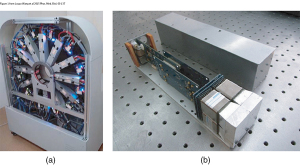Abstract
The Trans-PET® BioCaliburn® LH is a commercial positron emission tomography (PET) system for animal imaging. The system offers a large transaxial field-of-view (FOV) of 13.0 cm to allow imaging of multiple rodents or larger animals. This paper evaluates and reports the performance characteristics of this system. Methods: in this paper, the system was evaluated for its spatial resolutions, sensitivity, scatter fraction, count rate performance and image quality in accordance with the National Electrical Manufacturers Association (NEMA) NU-4 2008 specification with modifications. Phantoms and animals not specified in the NEMA specification were also scanned to provide further demonstration of its imaging capability. Results: the spatial resolution is 1.0 mm at the center. When using a 350–650 keV energy window and a 5 ns coincidence time window, the sensitivity at the center is 2.04%. The noise equivalent count-rate curve reaches a peak value of 62 kcps at 28 MBq for the mouse-sized phantom and a peak value of 25 kcps at 31 MBq for the rat-sized phantom. The scatter fractions are 8.4% and 17.7% for the mouse- and rat-sized phantoms, respectively. The uniformity and recovery coefficients measured by using the NEMA image-quality phantom both indicate good imaging performance, even though the reconstruction algorithm provided by the vendor does not implement all desired corrections. The Derenzo-phantom images show that the system can resolve 1.0 mm diameter rods. Animal studies demonstrate the capabilities of the system in dynamic imaging and to image multiple rodents. Conclusion: the Trans-PET® BioCaliburn® LH system offers high spatial resolution, a large transaixal FOV and adequate sensitivity. It produces animal images of good quality and supports dynamic imaging. The system is an attractive imaging technology for preclinical research.
Document Credits
Luyao Wang1,2, Jun Zhu1,2, Xiao Liang1,2, Ming Niu1,2, Xiaoke Wu1,2, Chien-Min Kao3, Heejong Kim3 and Qingguo Xie1,2
1 Huazhong University of Science and Technology, Wuhan, Hubei 430074, People’s Republic of China
2 Wuhan National Laboratory for Optoelectronics, Wuhan, Hubei 430074, People’s Republic of China
3 The University of Chicago, Chicago, IL, USA

